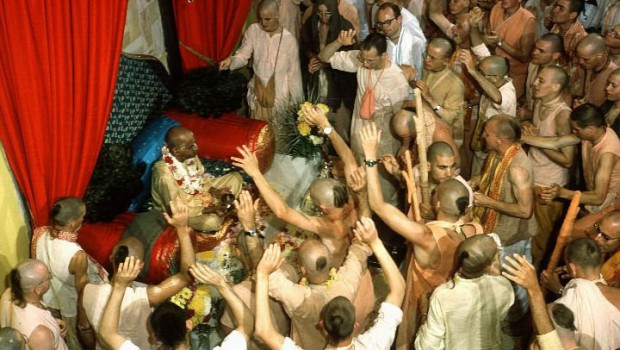Ekadasi Vrata
To observe Ekadasi-vrata and Dvadasi-vrata means to please the Supreme Personality of Godhead. Those interested in advancing in krsna consciousness must observe ekadasi-vrata regularly.
SB 4.28.35-36
We can definitely see that to advance in Krsna consciousness one must control his bodily weight. If one becomes too fat, it is to be assumed that he is not advancing spiritually. Srila Bhaktisiddhanta Sarasvati Thakura severely criticized his fat disciples. The idea is that one who intends to advance in Krsna consciousness must not eat very much. Devotees used to go to forests, high hills or mountains on pilgrimages, but such severe austerities are not possible in these days. One should instead eat only prasada and no more than required. ACCORDING TO THE VAISNAVA CALENDAR, THERE ARE MANY FASTS, SUCH AS EKADASI AND THE APPEARANCE AND DISAPPEARANCE DAYS OF GOD AND HIS DEVOTEES. ALL OF THESE ARE MEANT TO DECREASE THE FAT WITHIN THE BODY SO THAT ONE WILL NOT SLEEP MORE THAN DESIRED AND WILL NOT BECOME INACTIVE AND LAZY. Overindulgence in food will cause a man to sleep more than required. This human form of life is meant for austerity, and austerity means controlling sex, food intake, etc. In this way time can be saved for spiritual activity, and one can purify himself both externally and internally. Thus both body and mind can be cleansed.
We can definitely see that to advance in Krsna consciousness one must control his bodily weight. If one becomes too fat, it is to be assumed that he is not advancing spiritually. Srila Bhaktisiddhanta Sarasvati Thakura severely criticized his fat disciples. The idea is that one who intends to advance in Krsna consciousness must not eat very much. Devotees used to go to forests, high hills or mountains on pilgrimages, but such severe austerities are not possible in these days. One should instead eat only prasada and no more than required. ACCORDING TO THE VAISNAVA CALENDAR, THERE ARE MANY FASTS, SUCH AS EKADASI AND THE APPEARANCE AND DISAPPEARANCE DAYS OF GOD AND HIS DEVOTEES. ALL OF THESE ARE MEANT TO DECREASE THE FAT WITHIN THE BODY SO THAT ONE WILL NOT SLEEP MORE THAN DESIRED AND WILL NOT BECOME INACTIVE AND LAZY. Overindulgence in food will cause a man to sleep more than required. This human form of life is meant for austerity, and austerity means controlling sex, food intake, etc. In this way time can be saved for spiritual activity, and one can purify himself both externally and internally. Thus both body and mind can be cleansed.
SB 7.14.20-23
Visuva, or Visuva-sankranti, means Mesa-sankranti, or the day on which the sun enters the sign Aries. Tula-sankranti is the day on which the sun enters the sign Libra. Both of these days occur only once within a year. The word yoga refers to a certain relationship between the sun and moon as they move in the sky. There are twenty-seven different degrees of yoga, of which the seventeenth is called Vyatipata. On the day when this occurs, one should perform the sraddha ceremony. A TITHI, OR LUNAR DAY, CONSISTS OF THE DISTANCE BETWEEN THE LONGITUDE OF THE SUN AND THAT OF THE MOON. SOMETIMES A TITHI IS LESS THAN TWENTY-FOUR HOURS. WHEN IT STARTS AFTER SUNRISE ON A CERTAIN DAY AND ENDS BEFORE THE SUNRISE OF THE FOLLOWING DAY, THE PREVIOUS TITHI AND THE FOLLOWING TITHI BOTH “TOUCH” THE TWENTY-FOUR-HOUR DAY BETWEEN THE SUNRISES. THIS IS CALLED TRYAHA-SPARSA, OR A DAY TOUCHED BY SOME PORTION OF THREE TITHIS.
Visuva, or Visuva-sankranti, means Mesa-sankranti, or the day on which the sun enters the sign Aries. Tula-sankranti is the day on which the sun enters the sign Libra. Both of these days occur only once within a year. The word yoga refers to a certain relationship between the sun and moon as they move in the sky. There are twenty-seven different degrees of yoga, of which the seventeenth is called Vyatipata. On the day when this occurs, one should perform the sraddha ceremony. A TITHI, OR LUNAR DAY, CONSISTS OF THE DISTANCE BETWEEN THE LONGITUDE OF THE SUN AND THAT OF THE MOON. SOMETIMES A TITHI IS LESS THAN TWENTY-FOUR HOURS. WHEN IT STARTS AFTER SUNRISE ON A CERTAIN DAY AND ENDS BEFORE THE SUNRISE OF THE FOLLOWING DAY, THE PREVIOUS TITHI AND THE FOLLOWING TITHI BOTH “TOUCH” THE TWENTY-FOUR-HOUR DAY BETWEEN THE SUNRISES. THIS IS CALLED TRYAHA-SPARSA, OR A DAY TOUCHED BY SOME PORTION OF THREE TITHIS.
Srila Jiva Gosvami has given quotations from many sastras stating that the sraddha ceremony of oblations to the forefathers should not be performed on Ekadasi tithi. WHEN THE TITHI OF THE DEATH ANNIVERSARY FALLS ON THE EKADASI DAY, THE SRADDHA CEREMONY SHOULD BE HELD NOT ON EKADASI BUT ON THE NEXT DAY, OR DVADASI. In the Brahma-vaivarta purana it is said:
ye kurvanti mahipala
sraddham caikadasi-dine
trayas te narakam yanti
data bhokta ca prerakah
sraddham caikadasi-dine
trayas te narakam yanti
data bhokta ca prerakah
IF ONE PERFORMS THE SRADDHA CEREMONY OF OBLATIONS TO THE FOREFATHERS ON THE EKADASI TITHI, THEN THE PERFORMER, THE FOREFATHERS FOR WHOM THE SRADDHA IS OBSERVED, AND THE PUROHITA, OR THE FAMILY PRIEST WHO ENCOURAGES THE CEREMONY, ALL GO TO HELL.




